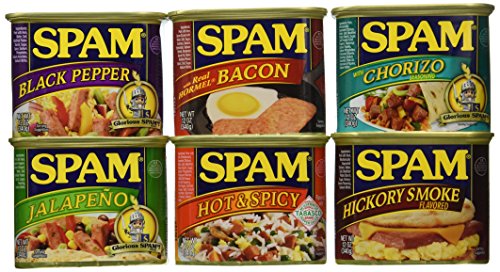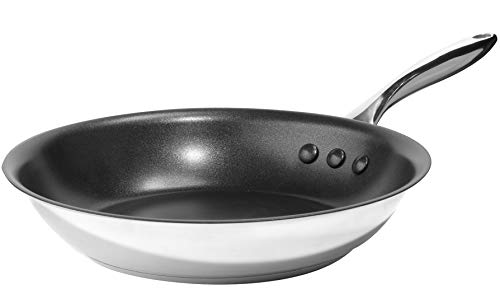Nowadays when you hear the word “spam,” you probably think of the unwanted emails you get from unknown sources soliciting you for money and information. Little do many people know, the term actually refers to and originates from the glorious canned luncheon meat of the same name. In the 90s when email became popular, users began referring to a classic Monty Python sketch to talk about these unwanted but ubiquitous messages. In the sketch, a couple is dining at a restaurant in which Spam is part of nearly every item on the menu, much to the chagrin of the wife. It’s a funny and weird look at people’s love/hate relationship with the meat:
 Spam with Real Hormel ...
Buy New $22.99
(as of 10:49 UTC - Details)
Before being the butt of a joke in 1970, though, it was on the losing end of soldiers’ jokes during WWII. As we’ll see later, Spam supplied our armed forces with many of their meals. Prior to WWII, however, it enjoyed a brief stint as a popular and innovative product born from the ingenuity of southern Minnesotans.
Spam with Real Hormel ...
Buy New $22.99
(as of 10:49 UTC - Details)
Before being the butt of a joke in 1970, though, it was on the losing end of soldiers’ jokes during WWII. As we’ll see later, Spam supplied our armed forces with many of their meals. Prior to WWII, however, it enjoyed a brief stint as a popular and innovative product born from the ingenuity of southern Minnesotans.
Since its inception in 1937, Spam has earned heaping amounts of both praise and scorn. It’s truly one of those foods that you either love or hate (and in my experience, the haters often haven’t even tried it!). As I’m sure you can already tell, I rather enjoy Spam. And I should; I was born in Spamtown, USA (Austin, MN, that is), where Hormel is headquartered and where Spam is produced. There’s even a fantastic Spam museum there, which is surprisingly popular among Hawaiians visiting the mainland (we’ll see why a bit later) as well as foreign tourists.
 Spam Sampler 12oz Cans...
Buy New $39.99 ($0.56 / Ounce)
(as of 07:15 UTC - Details)
Spam Sampler 12oz Cans...
Buy New $39.99 ($0.56 / Ounce)
(as of 07:15 UTC - Details)
Today, we’re going to explore Spam’s fascinating, oscillating history, find out what this gelatinous and confusing block of meat really is, and share some recipes for you to try out. Tasty and cheap, Spam’s been a food icon for over 75 years, and it’s time you knew the story behind it and put some on your plate.
Spam’s Humble Beginnings
 Spam Oven Roasted Turk...
Buy New $23.83
(as of 10:49 UTC - Details)
In the late 1920s, canned meat became a common source of food for commercial endeavors — restaurants, hotels, even butcher shops and delis. As the depression took hold, its popularity increased, as companies didn’t wish to be held hostage by fresh meat’s high prices nor by its seasonality. (Believe or not, fresh and natural meat is seasonal!) Whole canned hams and chickens, on the other hand, were always available, lasted nearly forever, and were cheap and easy to cook — slice and heat and you’re done!
Spam Oven Roasted Turk...
Buy New $23.83
(as of 10:49 UTC - Details)
In the late 1920s, canned meat became a common source of food for commercial endeavors — restaurants, hotels, even butcher shops and delis. As the depression took hold, its popularity increased, as companies didn’t wish to be held hostage by fresh meat’s high prices nor by its seasonality. (Believe or not, fresh and natural meat is seasonal!) Whole canned hams and chickens, on the other hand, were always available, lasted nearly forever, and were cheap and easy to cook — slice and heat and you’re done!
Hormel was the leader for this category of food in both inventiveness and food quality. They were one of the first major companies to try canning whole meats, and used quality products to do so. This included the use of pork shoulder, which is a decent cut of meat, but mostly ignored in that era because of the time and energy it took to get the meat off the bone. Hormel’s product was more expensive, so competitors just undercut prices with cheaper ingredients (leftover parts, basically), and the now-famed Hormel had to do something different to stand out. Company president Jay Hormel had an idea for a household product, something family-sized, that would set Hormel apart from the rest.

And so in 1937, Spam was born, after two years of testing various products and recipes. The name was the result of a contest that Jay Hormel held at his mansion in southern Minnesota as part of a New Year’s Eve party. A dapper fellow named Ken Daigneau, brother of a Hormel VP, shouted out “Spam!” almost instantly. He was an actor from New York, but Spam would be his crowning achievement — probably not what he had in mind when he started his career. The word stands for either spiced ham, or shoulder of pork and ham, which is odd, as the original product didn’t actually have any ham in it! It was added in later, as so many people just assumed it was there. It’s likely that after tasting the yet-unnamed meat at the party, Mr. Daigneau thought it mainly a ham product.
 Spam Classic, 12 Ounce...
Buy New $32.76
(as of 07:35 UTC - Details)
Spam Classic, 12 Ounce...
Buy New $32.76
(as of 07:35 UTC - Details)
 Spam Single Classic, 2...
Buy New $25.44
(as of 11:10 UTC - Details)
Spam Single Classic, 2...
Buy New $25.44
(as of 11:10 UTC - Details)
 Hawaii Cooks with Spam...
Best Price: $1.99
Buy New $2.99
(as of 07:45 UTC - Details)
Hawaii Cooks with Spam...
Best Price: $1.99
Buy New $2.99
(as of 07:45 UTC - Details)
 Ozeri 10-Inch Stainles...
Buy New $27.62
(as of 11:05 UTC - Details)
Ozeri 10-Inch Stainles...
Buy New $27.62
(as of 11:05 UTC - Details)





